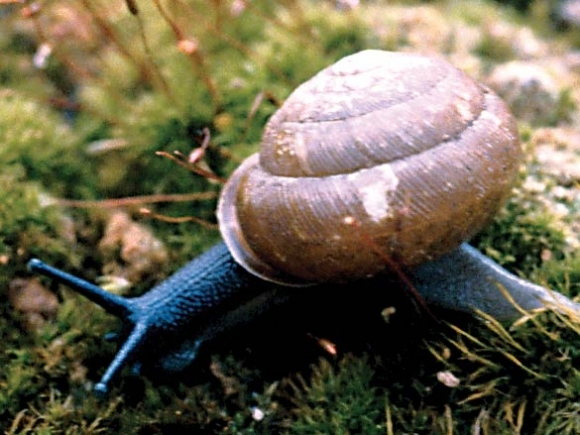Twice threatened

In the land of the noonday sun, there lives a noonday snail. The noonday globe snail, Petera clarkia Nantahala is a medium-sized snail, about three-quarters inch wide and one-half inch high. This little slimeball is known only from about 2 miles of high calcareous cliffs in the Nantahala Gorge in Western North Carolina.
It is a denizen of the damp, living on wet cliffs intersected by small streams and waterfalls. No nouveau snail, the noonday globe prefers old forests with mature trees, a diverse plant community, lots of humus and lots of calcium. The calcium is the monkey on its back – literally: calcium is the main component of the snail’s shell and wet slopes with calcareous rocks are not an easy find in the land of the noonday sun.
The noonday globe was listed as threatened in July 1978. While it was likely never too widely distributed, it surely had more room to roam before railroads and highways came to the gorge. Not only did the road and rail usurp real estate, but clearing for the infrastructure opened the canopy, sending ol’ Sol’s rays deep into the land of the noonday sun — drying things along the way. And if you’re a pretty cool snail the last thing you want is to be basking in the sunlight.
We are learning about this critter at a, well, snail’s pace. We don’t know how it reproduces (we assume it’s snail-like), we don’t know what it eats (we assume it’s snail food) — other members of the genus Petera feed on the mycelia of fungi. Sure, it all seems pretty secretive and sedate, but don’t be fooled — when it’s wet outside, like a heavy mist or light rain, well then P. c. Nantahala might be found struttin’ its stuff right out on top of the ground.
Can we be bothered with a snail? I mean there’s a lot of really BIG stuff happening — sheesh, there’s a Super Bowl Sunday for god’s sake. Most of us never even knew that in this big ole world, stuck in the middle of some god-forsaken cliffs in a wrinkle of time called the Nantahala Gorge there lived a snail that was a different species from other snails. Should we care?
We could talk about how in these times extinction is an endless blur while speciation continues on a timeline that has become entirely foreign to us. Also Leopold put it pretty succinctly: “The last word in ignorance is the man who says of an animal or plant, “What good is it?" If the land mechanism as a whole is good, then every part is good, whether we understand it or not. If the biota, in the course of aeons, has built something we like but do not understand, then who but a fool would discard seemingly useless parts? To keep every cog and wheel is the first precaution of intelligent tinkering.”
Related Items
The fate of this slimy, innocuous little cog is in question. The Tellico Fire burned through the noonday globe’s habitat. I walked part of the Tellico Fire with Josh Kelly of MountainTrue. We hiked in along Wesser Creek Trail and at one point found the shells of snails that did not make it. This was not noonday globe habitat and I don’t have any idea of fire intensity or severity in the noonday globe’s habitat, but I know for some snails the fire was bad news.
No one will know the fate of the noonday snail in the land of the noonday sun till later this spring when biologists go in to survey the population. I don’t know about you, but I’m pulling for the little slimeball.
Don Hendershot is a writer and naturalist. He can be reached at This email address is being protected from spambots. You need JavaScript enabled to view it..









